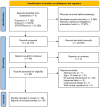Strength and conditioning in dance: A systematic review and meta-analysis
- PMID: 38874993
- PMCID: PMC11235645
- DOI: 10.1002/ejsc.12111
Strength and conditioning in dance: A systematic review and meta-analysis
Abstract
To assess the evidence for the effect of strength and conditioning on physical qualities and aesthetic competence in dance populations, three electronic databases (PubMed, Scopus, SPORTDiscus) were searched (until September 2022) for studies that met the following criteria: (i) dancers aged >16 years; (ii) structured strength and conditioning intervention; and (iii) with physical qualities and aesthetic competence as outcome measures. Methodological quality and risk of bias of the included studies were assessed through the systematic review tool "QualSyst". Meta-analyses of effect sizes (Hedges' g) with forest plots explored the effects of the strength and conditioning interventions. Thirty-six studies met the inclusion criteria and were included in this review. Meta-analysis indicated strength and conditioning significantly (p < 0.05) improved lower body power (g = 0.90, 95% CI: 0.53-1.27), upper body strength (g = 0.98, 95% CI: 0.39-1.57), lower body strength (g = 1.59, 95% CI: 0.97-2.22), and flexibility (g = 0.86, 95% CI: 0.05-1.66). Strength and conditioning interventions were found to be effective at improving physical qualities in dancers, recommending their participation in additional sessions to enhance overall fitness and ultimately dance performance. It is recommended that future strength and conditioning intervention research should include sample size calculations, with participants recruited from a specific dance genre and skill level in order to evaluate how strength and conditioning influences dance performance.
Keywords: aesthetics; dancing; physical fitness; plyometric exercise; resistance training; vibration.
© 2024 The Authors. European Journal of Sport Science published by Wiley‐VCH GmbH on behalf of European College of Sport Science.
Conflict of interest statement
The authors report there are no competing interests to declare.
Figures
Similar articles
-
Dose-Response Relationships of Resistance Training in Healthy Old Adults: A Systematic Review and Meta-Analysis.Sports Med. 2015 Dec;45(12):1693-720. doi: 10.1007/s40279-015-0385-9. Sports Med. 2015. PMID: 26420238 Free PMC article.
-
Physical exercise training interventions for children and young adults during and after treatment for childhood cancer.Cochrane Database Syst Rev. 2016 Mar 31;3(3):CD008796. doi: 10.1002/14651858.CD008796.pub3. Cochrane Database Syst Rev. 2016. PMID: 27030386 Free PMC article.
-
Effects of Supervised vs. Unsupervised Training Programs on Balance and Muscle Strength in Older Adults: A Systematic Review and Meta-Analysis.Sports Med. 2017 Nov;47(11):2341-2361. doi: 10.1007/s40279-017-0747-6. Sports Med. 2017. PMID: 28573401
-
Effect of Strength Training Programs in Middle- and Long-Distance Runners' Economy at Different Running Speeds: A Systematic Review with Meta-analysis.Sports Med. 2024 Apr;54(4):895-932. doi: 10.1007/s40279-023-01978-y. Epub 2024 Jan 2. Sports Med. 2024. PMID: 38165636 Free PMC article.
-
Interventions for promoting habitual exercise in people living with and beyond cancer.Cochrane Database Syst Rev. 2018 Sep 19;9(9):CD010192. doi: 10.1002/14651858.CD010192.pub3. Cochrane Database Syst Rev. 2018. PMID: 30229557 Free PMC article.
Cited by
-
A meta-analysis of the effects of strength training on physical fitness in dancers.Front Physiol. 2025 Feb 27;16:1511833. doi: 10.3389/fphys.2025.1511833. eCollection 2025. Front Physiol. 2025. PMID: 40084178 Free PMC article.
-
A meta-analysis of the effects of plyometric training on muscle strength and power in martial arts athletes.BMC Sports Sci Med Rehabil. 2025 Jan 23;17(1):12. doi: 10.1186/s13102-025-01059-9. BMC Sports Sci Med Rehabil. 2025. PMID: 39849510 Free PMC article.
References
-
- Angioi, Manuela , Metsios George, Twitchett Emily A., Koutedakis Yiannis, and Wyon Matthew. 2012. “Effects of Supplemental Training on Fitness and Aesthetic Competence Parameters in Contemporary Dance: a Randomised Controlled Trial.” Medical Problems of Performing Artists 27(1): 3–8. 10.21091/mppa.2012.1002. - DOI - PubMed
-
- Annino, Giuseppe , Padua Elvira, Castagna Carlo, Salvo Valter Di, Minichella Stefano, Tsarpela Olga, Manzi Vincenzo, and D'Ottavio Stefano. 2007. “Effect of Whole Body Vibration Training on Lower Limb Performance in Selected High‐Level Ballet Students.” The Journal of Strength & Conditioning Research 21(4): 1072–1076. 10.1519/r-18595.1. - DOI - PubMed
-
- Brown, Andrea C. , Wells Tobin J., Schade Margaret L., Smith Denise L., and Fehling Patricia C.. 2007. “Effects of Plyometric Training versus Traditional Weight Training on Strength, Power, and Aesthetic Jumping Ability in Female Collegiate Dancers.” Journal of Dance Medicine and Science 11(2): 38–44. 10.1177/1089313x0701100202. - DOI
Publication types
MeSH terms
LinkOut - more resources
Full Text Sources
Miscellaneous


